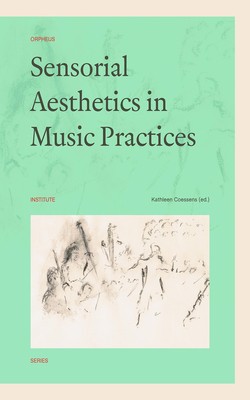
- Išsiųsime per 10–14 d.d.
- Leidėjas: Leuven University Press
- Metai: 2019
- Puslapiai: 200
- ISBN-10: 9462701849
- ISBN-13: 9789462701847
- Formatas: 20.3 x 27.9 x 1.5 cm, minkšti viršeliai
- Kalba: Anglų
- Extra -15 % nuolaida šiai knygai su kodu: ENG15
Sensorial Aesthetics in Music Practices + nemokamas atvežimas! | knygos.lt
Atsiliepimai
Aprašymas
The Western history of aesthetics is characterised by tension between theory and practice. Musicians listen, play, and then listen more profoundly in order to play differently, adapt the body, and sense the environment. They become deeply involved in the sensorial qualities of music practice. Artistic practice refers to the original meaning of aesthetics--the senses. Whereas Baumgarten and Goethe explored the relationship between sensibility and reason, sensation and thinking, later philosophers of aesthetics deemed the sensorial to be confused and unreliable and instead prioritised a cognitive or objective approach.
Written by authors from the fields of philosophy, composition, performance, and artistic practice, Sensorial Aesthetics in Music Practices repositions aesthetics as a domain of the sensible and explores the interaction between artists, life, and environment. Aesthetics becomes a field of sensorial and embodied experience involving temporal and spatial influences, implicit knowledge, and human characteristics.
Contributors: Kathleen Coessens (Koninklijk Conservatorium Brussel, Orpheus Institute), Tim Ingold (University of Aberdeen), Michaël Levinas (Conservatoire National Supérieur de Musique de Paris), Fabien Lévy (Hochschule für Musik Detmold), Lasse Thoresen (Norwegian Academy of Music), Vanessa Tomlinson (Queensland Conservatorium of Music), Salomé Voegelin (University of the Arts London)
EXTRA 15 % nuolaida su kodu: ENG15
Akcija baigiasi už 10:41:04
Nuolaidos kodas galioja perkant nuo 10 €. Nuolaidos nesumuojamos.

- Leidėjas: Leuven University Press
- Metai: 2019
- Puslapiai: 200
- ISBN-10: 9462701849
- ISBN-13: 9789462701847
- Formatas: 20.3 x 27.9 x 1.5 cm, minkšti viršeliai
- Kalba: Anglų
The Western history of aesthetics is characterised by tension between theory and practice. Musicians listen, play, and then listen more profoundly in order to play differently, adapt the body, and sense the environment. They become deeply involved in the sensorial qualities of music practice. Artistic practice refers to the original meaning of aesthetics--the senses. Whereas Baumgarten and Goethe explored the relationship between sensibility and reason, sensation and thinking, later philosophers of aesthetics deemed the sensorial to be confused and unreliable and instead prioritised a cognitive or objective approach.
Written by authors from the fields of philosophy, composition, performance, and artistic practice, Sensorial Aesthetics in Music Practices repositions aesthetics as a domain of the sensible and explores the interaction between artists, life, and environment. Aesthetics becomes a field of sensorial and embodied experience involving temporal and spatial influences, implicit knowledge, and human characteristics.
Contributors: Kathleen Coessens (Koninklijk Conservatorium Brussel, Orpheus Institute), Tim Ingold (University of Aberdeen), Michaël Levinas (Conservatoire National Supérieur de Musique de Paris), Fabien Lévy (Hochschule für Musik Detmold), Lasse Thoresen (Norwegian Academy of Music), Vanessa Tomlinson (Queensland Conservatorium of Music), Salomé Voegelin (University of the Arts London)




Atsiliepimai